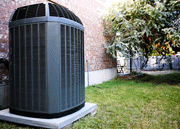The air conditioner is a marvelous invention – especially when you live in southern Arizona. But how does it actually work?
After 60 years spent installing and servicing air conditioning systems, the staff at Hansberger Refrigeration & Electric have  become quite familiar with every detail of how they work. Here is a short primer on how your air conditioner will keep you cool this summer.
become quite familiar with every detail of how they work. Here is a short primer on how your air conditioner will keep you cool this summer.
First, you need to understand what a refrigerant is. Refrigerants, such as the old R-22 refrigerant or the newer R-410A, are substances with very low boiling points. R-410A, for instance, boils/ evaporates at 55 degrees below zero. When it evaporates it absorbs heat from its surroundings. However, if you place it under very high pressure, the refrigerant will be forced to condense back into a cold liquid.
An air conditioner utilizes these refrigerant qualities by having two radiator-like coils. One coil is located inside the house, and one outside. When the refrigerant passes through the indoor coil, it is allowed to evaporate; this absorbs the heat from the air passing through making the air cold.
The refrigerant, which is now a gas, is then pumped into the outdoor coil by a compressor. The compressor pressurizes the refrigerant enough that it turns back into a liquid when cooled by the outside air, releasing the heat it had absorbed into the outdoor air. Thus we are moving heat from inside the home to outside.
The liquid refrigerant then flows back to the indoor coil, passing through an expansion valve that releases the pressure so that it can evaporate thus absorbing more heat, moving it outside repeating the cycle over and over.
The rest of the A/C system consists of your home’s air ducts, your thermostat and two electric fans. The fan for the outdoor coils draws outside air through the coils. This air is absorbing the heat moved from inside the home cooling the refigerant until it condenses into a liquid that feeds the expansion valve. The other fan moves air through the indoor coil and blows cold air that’s produced into the duct system and throughout the house. The thermostat constantly measures the indoor temperature and tells the air conditioner when it needs to turn on to cool or off becuse it has reached your set-point.
If you have any other questions about your air conditioner, contact us at Hansberger Refrigeration & Electric in Yuma.
Our goal is to help educate our customers about energy and home comfort issues (specific to HVAC systems). For more information about air conditioners and other HVAC topics, download our free Home Comfort Resource guide.
Hansberger Refrigeration & Electric Co services the Yuma area in Arizona. Visit our website to see our special offers and get started today!

